Whether you’re into collecting diecast cars, building toy train layouts, racing slot cars, or doing any type of modeling, you’ll undoubtedly come across the terms “scale” or “gauge” as you grow into the hobby. So we figured it’d be helpful to explain what those two terms mean and, more importantly, how they relate to model size.
Getting Familiar with Scale Ratios
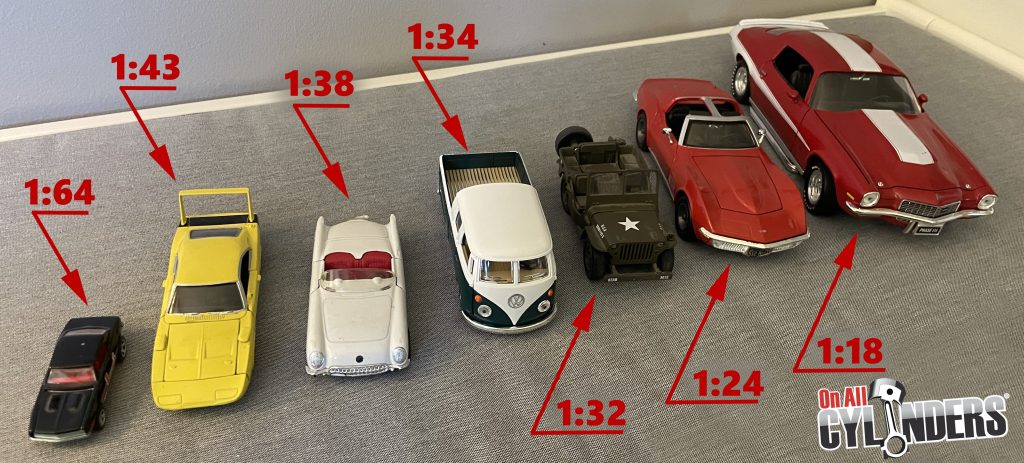
The first thing to understand is how scale ratios work. Depicted in a 1:XX format, the scale ratio is a relative measure based on the size of the original car, boat, airplane, or whatever. The smaller the number on the right side of the ratio (1:64, 1:48, 1:18, etc.) the larger the model will be.
So in terms of physical size, a 1:32 scale model of a 1967 Camaro would be smaller than a 1:18 scale model of the same car, make sense?
The math behind scale ratios is simple: If you take the dimensions of a 1:64 scale model and multiply them by 64, you’ll get the accurate dimensions of the real thing.
Here’s another way to explain it: A 1:32 scale car would be exactly 1/32nd the size of the original car it’s modeled after. So if you put 32 models of the same 1:32 scale model car in a line end-to-end, you’d get the same length of the full size vehicle.
Scale ratios are a handy way to represent a wide range of objects that have differing sizes. And by using the same scale, you’re able to keep everything consistent. For example, if you set a 1:32 scale car into a 1:32 scale gas station, the two will make a matching scene.

There’s no single set scale size however, and there’s a good chance you’ll see a range of scales when shopping for model cars, trucks, airplanes, and beyond. That’s especially true if you’re buying model kits from other parts of the globe, that may not closely follow traditional North American scale trends. For example, the 1:34 scale might be popular in Europe, where in the U.S.A., you could find that 1:32 is more prevalent.
But here are a few of the more common model car scales you’ll come across:
- 1:64 – This is the familiar “Hot Wheels” size that’s common for toy cars, but you’ll also see it with larger models, like sailing ships, spacecraft, monsters, and other fantasy/sci-fi stuff.
- 1:24 – Larger than 1:64 scale, many modelers like this size because it’s possible to create entire scenes without a massive footprint on a tabletop or shelf.
- 1:18 – This scale is popular with collectors as the larger size means the models are often impressively detailed with moving parts like wheels, doors, and hoods.
Gauges vs. Scales
When you’re shopping for models, you may often hear the word “gauge” being used interchangeably with “scale,” but don’t confuse the two. The term gauge is typically related to railroading—yet there is a significant relationship to collectable cars too, which we’ll get to in a sec.
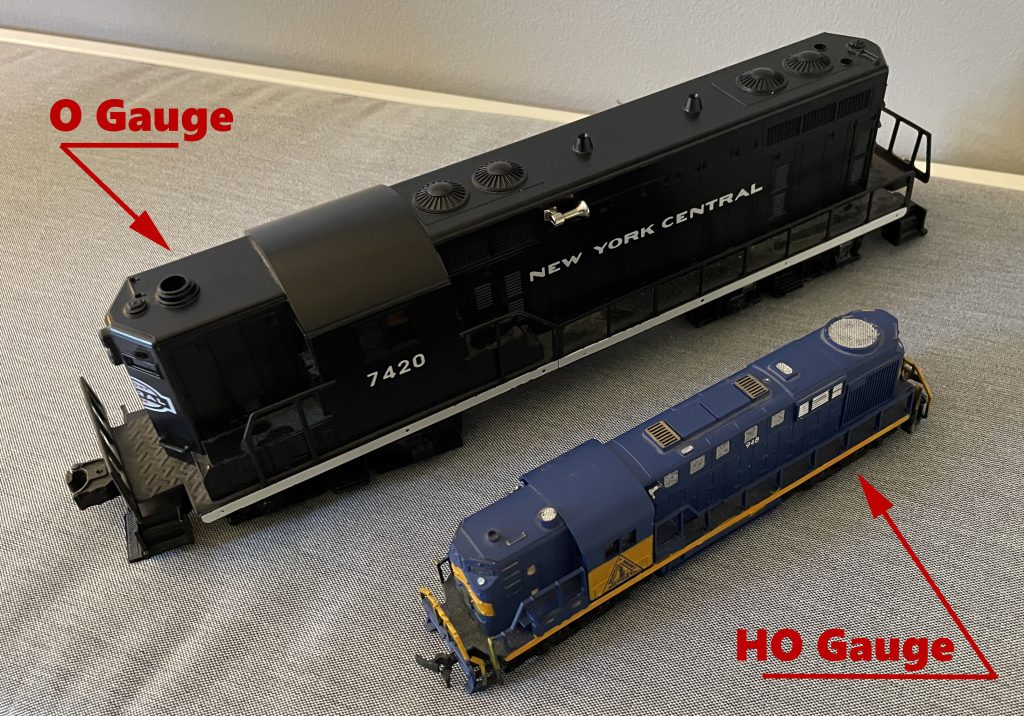
Gauge is a reference to the width of the railroad track, so there’s an obvious correlation to the sizes of the engines and train cars. In fact, the word gauge is borrowed from the dictionary of full-size railroading, IE a “narrow gauge” railroad is one where the rails are spaced closer together than a traditional railroad track width.
So, how do model railroad gauges relate to diecast collectable cars?
Simple, since the popularity of model railroading exploded in the 1950s, many car model makers began shifting to the gauges that the trains used. That way, model railroaders could dress-up their train layouts with similar sized cars and trucks for a more realistic display.
You may also enjoy this article: 5 Things Model Trains Teach You About Wrenching on Cars
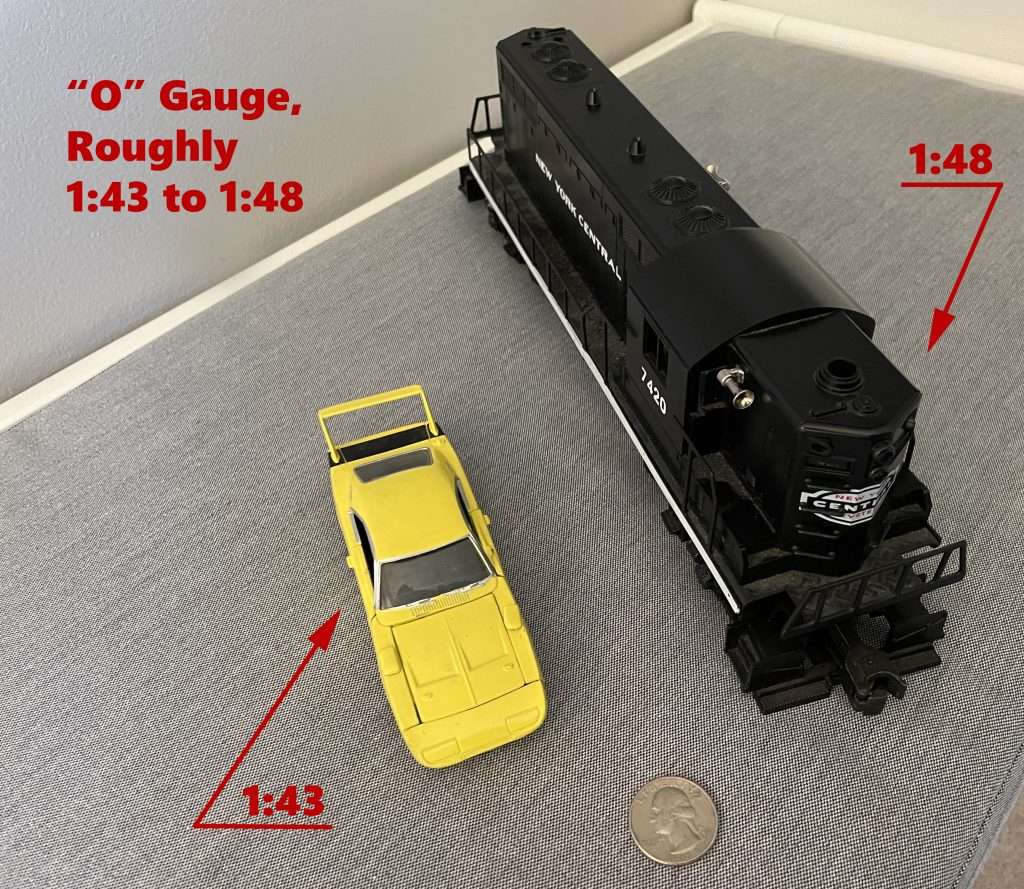
While the scale relationships are not always perfectly consistent, as a general rule, popular “O” gauge trains are in the neighborhood of 1:48 to 1:43 scale.
But it’s important to point out that manufacturers regularly took some necessary liberties with scaling-down locomotives and engines. That tactic was often required simply to help larger locomotives navigate turns around a coffee table (the iconic, yet massive, GG-1 engine is a perfect example), so scale size isn’t always perfectly consistent even within a single train manufacturer.
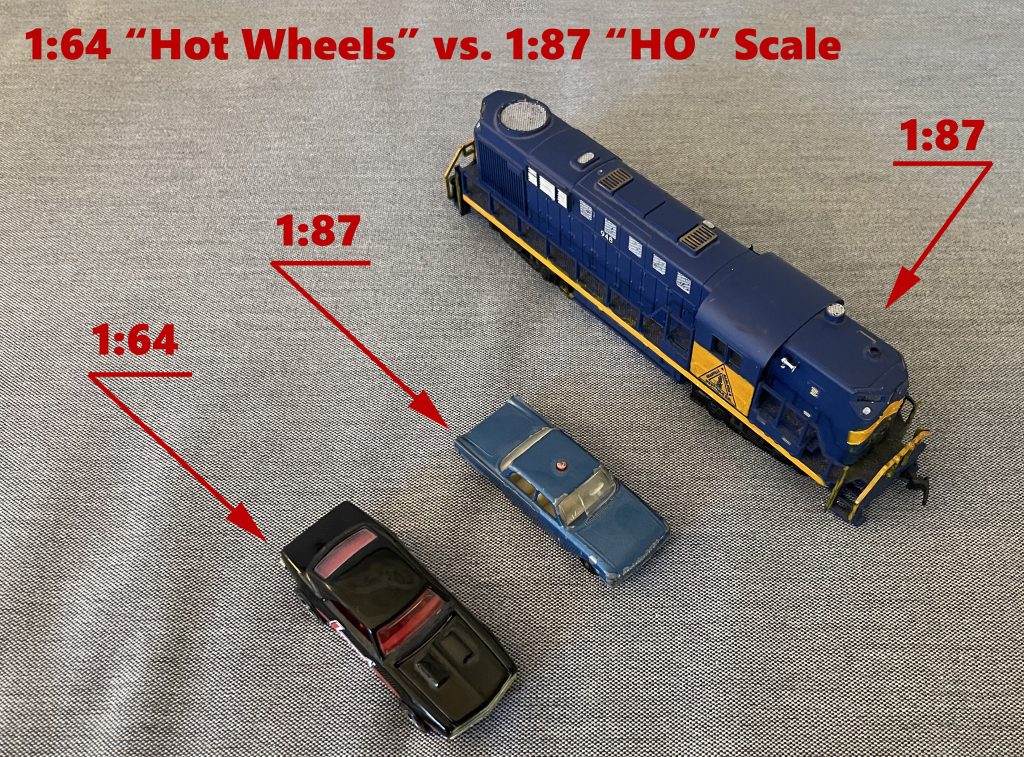
When it comes to sizing parameters, same deal with HO gauge. Though HO gauge is literally “Half-O” it’s not always consistent. In the strictest sense, HO is considered around 1:87 scale, but given the subtle differences in size, many HO model train layouts are populated with slightly larger 1:64 scale vehicles—that’s simply due to the massive popularity and availability of cars like Hot Wheels.
Hot Wheels, Matchbox & HO Car Scales
Speaking of HO car sizing, it’s also important to note that the traditional 1:64 Hot Wheels size wasn’t always universal either. And that’s especially true when looking at the evolution of Matchbox cars.
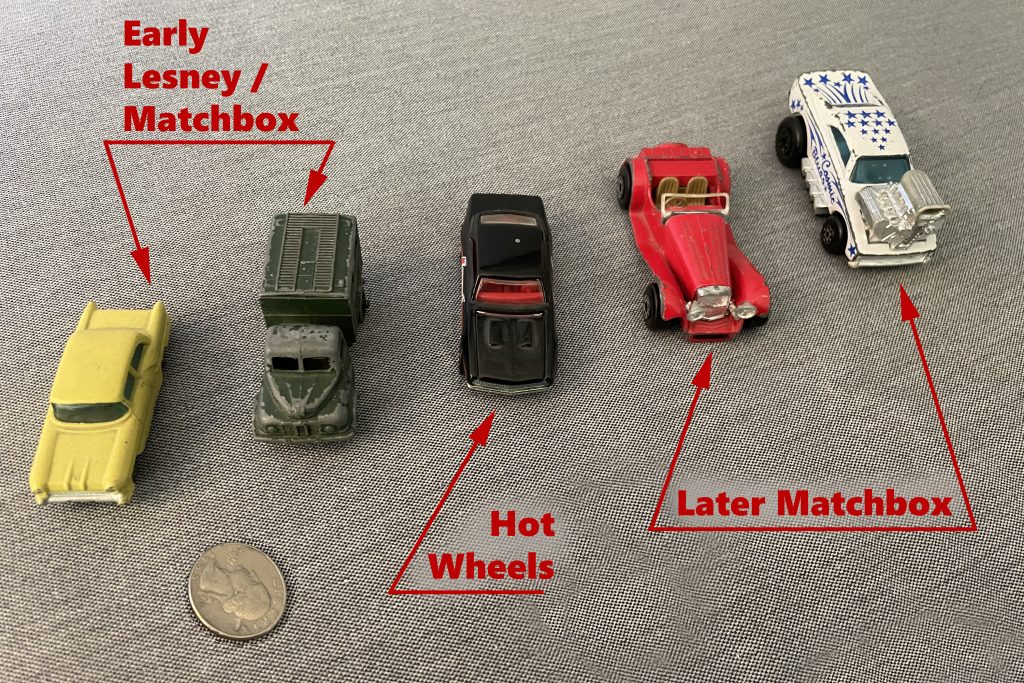
Matchbox cars came from the Lesney company of Great Britain and they actually started out smaller than the typical Hot Wheels car, closer to that true 1:87 HO scale we alluded to earlier. Over a few decades of evolution, Matchbox cars eventually caught up to, then eclipsed, 1:64 Hot Wheels cars in scale size. We wrote an in-depth article on the history of Hot Wheels and Lesney that you can read here, Hot Wheels: The Tiny Toy Cars That Inspired Millions of Gearheads Worldwide
At any rate, the takeaway here is that all of these 1:87 scale, 1:64 Hot Wheels, and larger Matchbox cars are often colloquially referred to as HO gauge. And that’s something you’ll often see when referencing slot cars too. So let’s talk about those here for a moment…
Scale & Slot Cars
Just like the model trains described above, slot car sets often come in different gauges or scales. And just like trains, some scales became smaller by necessity.
For starters, 1:64 HO slot car sets are popular because they allow you to run a relatively long course without smashing into your living room baseboards.
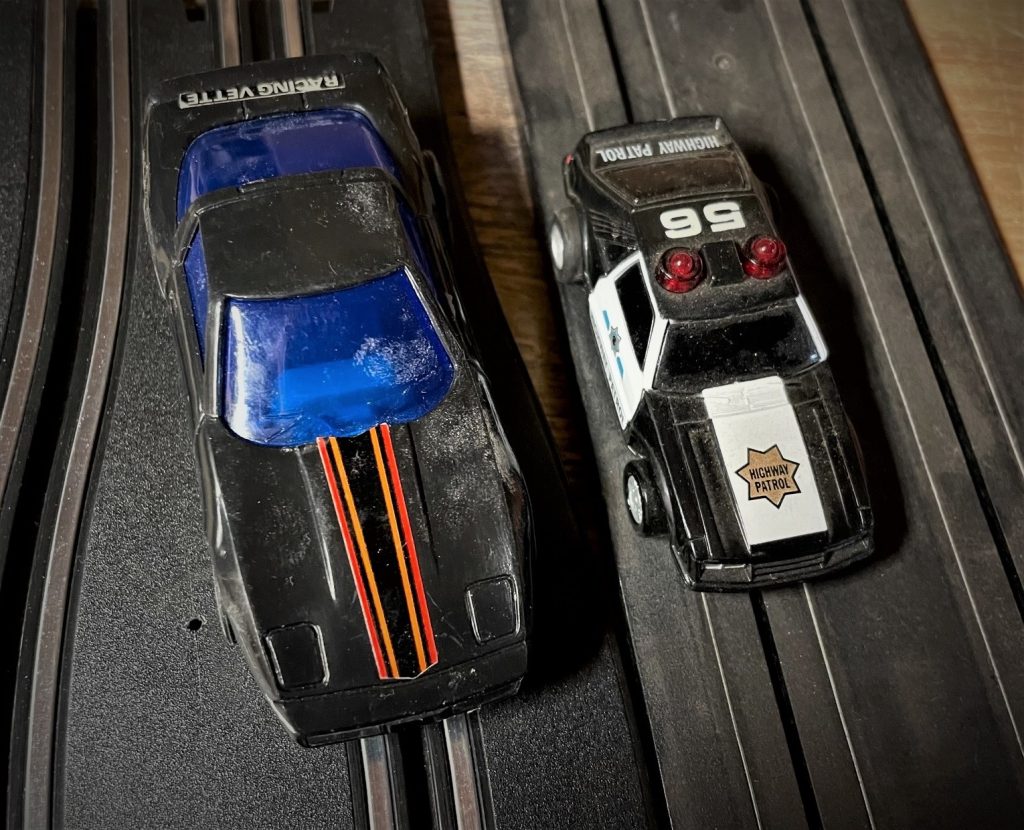
But for the same reasons that diecast collectors like larger model cars for more detail, many slot car enthusiasts gravitate to the larger sizes as well, including 1:43, 1:32, and even 1:24 scales.
Though running larger scale slot cars obviously comes at the expense of space in your home, the plus side is that the slot cars themselves are also extremely collectable simply as static shelf display pieces.
Which Model Scale is Right for You?
There are two easy questions to ask to figure that out:
- How Much Space Do You Have?
- What Are Your Plans?
If you’re collecting just a few diecast models for display, then you may prefer larger scales, like 1:24, 1:18, and up. But if you plan to continually grow your collection, a smaller scale might work better as your collection expands across you shelves.
And sometimes you may be locked-in to a specific scale by necessity. For example, if you want a model of a B-36 Peacemaker in your office, then 1:72 might be your only option—unless your coworkers don’t mind its tail section jutting into the hallway.
If you’re into slot car racing, your scale might entirely be dependent on the available space to set up your track too. Same deal with model trains—your best train gauge options could be dictated by the real estate of your proposed layout.
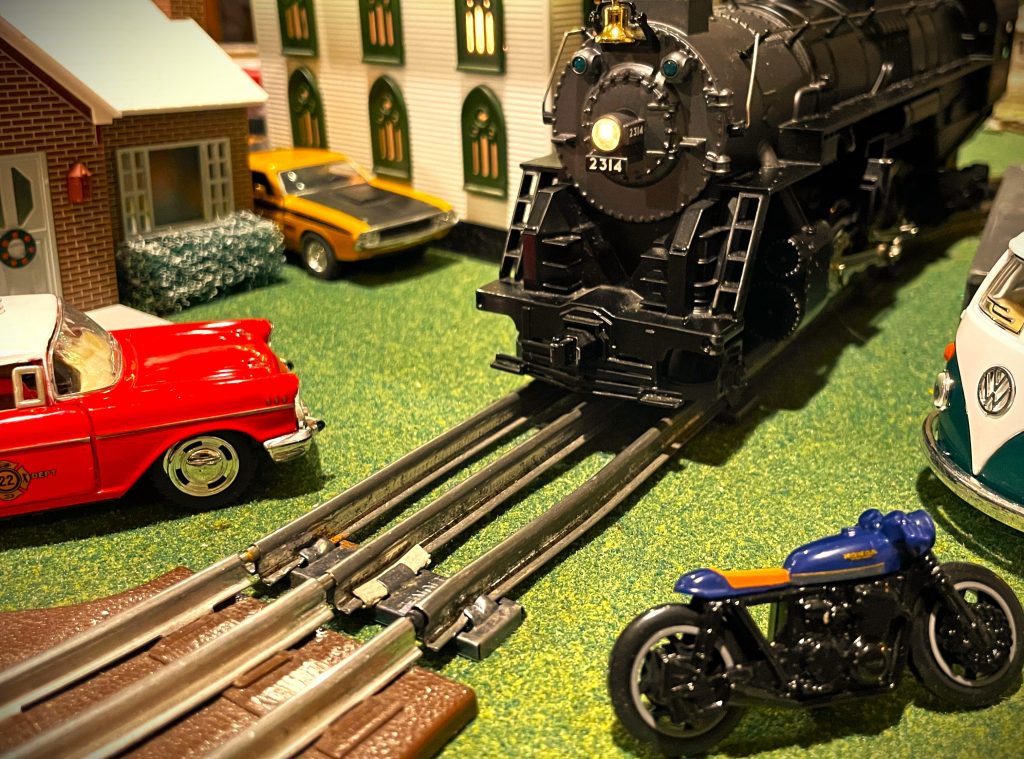
But most importantly, there’s no rule that says you have to stick to a single size.
Honestly, unless you’re strictly adhering to a specific scale, given the subtle nuances between similar sizes, you can set a 1:38 diecast car next to a 1:32 diecast car and most folks wouldn’t be able to tell the difference. In fact, next time you’re at a holiday train display or model show, take a closer look at the details—it’s not uncommon to see a range of scales coexisting peacefully in a single scene.
A Pair of Videos on Model Scales & Sizes
The folks at Summit Racing put together a quick video on diecast model car scales and sizes that provides a more visual presentation of what we’ve covered in this article. Watch it here:
And for an even more advanced technical discussion on the topic, we recommend a documentary called “Out of Scale.” You can check it out below:

Alot of cool tid-bits! I’m gonna be watching out!
I have been looking for years of the store or the plastic model company that remakes the pyro plastic plane,truck,cars,guns line was made in 50’s too the early 70’s.do you know of anyone who still sells these models?
Hey Charles, I know some Pyro models were being reproduced after the company folded, but I don’t they’re still being made today (I may be wrong though). The best I could find were a few NOS models from decades ago being sold in online auctions and other model enthusiast sites.